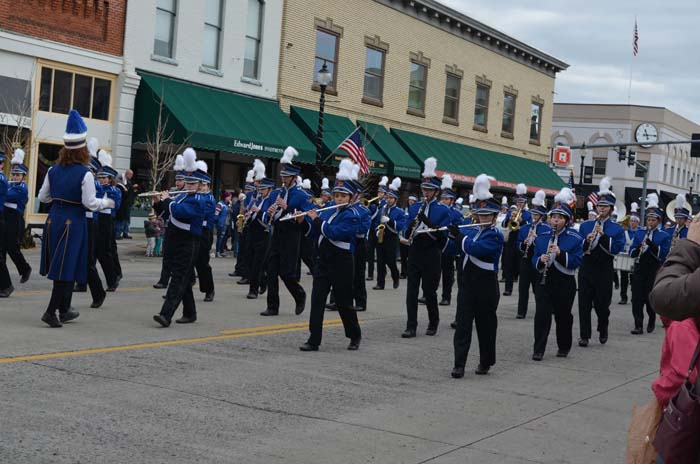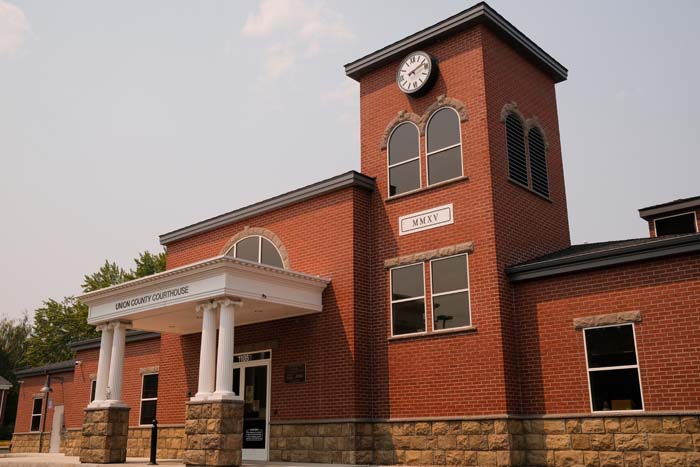The Observer’s top 10 COVID-19 stories
Published 5:45 am Thursday, December 31, 2020

- The La Grande High School Marching Band participates in the town’s Veterans Day parade in 2017. But the COVID-19 pandemic led to the parade’s cancellation in 2020, along with a host of other annual events throughout the region and state.
10. Pandemic prompts innovative graduations
Innovation took center stage on the graduation front in Northeastern Oregon in 2020 due to the COVID-19 pandemic.
None of the public high school schools in Union or Wallowa counties or Eastern Oregon University, La Grande, conducted conventional commencements because of state restrictions limiting large gatherings. Ceremonies, instead, were as creative as they were unorthodox.
La Grande High took to the road with a drive-thru graduation on May 30. Members of the class of 2020 rode in family vehicles on K Avenue past the high school’s main entrance where a member of the La Grande School Board presented diplomas to the graduates and School District Superintendent George Mendoza greeted each.
Students at Cove, Elgin, Imbler and Enterprise high schools received their diplomas at ceremonies on their football fields with the friends and family of graduates staying in their vehicles. Wallowa High School took much the same approach for its 10 graduates, except at Tamkaliks Pow-Wow grounds. Imbler students had the longest wait for diplomas, with commencement on July 4.
Powder Valley and Union high school graduates received their diplomas in the gyms of their schools before audiences of family members.
The La Grande Drive-in theater also was a big part of graduation activities. Powder Valley and Union High graduates went to the drive-in after commencements for slideshows recounting class experiences and to view video recordings of speeches by classmates and school officials.
Eastern Oregon University held its June 13 graduation entirely online.
9. Adapting to the pandemic
Adaptation was the theme of 2020 for many a local institution. From the quiet scene of the local library to the celebratory atmosphere often found in churches, the pandemic demanded creative solutions.
Cook Memorial Library in downtown La Grande took the lead from local restaurants and moved to a takeout system, where patrons called ahead and picked up orders. Libraries in Union and Wallowa counties took similar steps, including limiting their indoor capacity and, at times, suspending late fees.
Many religious organizations moved their services online. Churches across Union County transitioned to online formats to prevent the spread of COVID-19 within their congregations, particularly in the wake of an outbreak at the Lighthouse Pentecostal Church in Island City.
Some local churches moved Christmas services online, and others held outdoor events where masks were mandatory. Some, however, moved ahead with regular services despite the risk of COVID-19.
The Grande Ronde Symphony held virtual concerts. Art Center East cut the number of vendors at its annual Handmade Holidays in November by 30% and implemented COVID-19 protocols.
Few institutions escaped change during the COVID-19 pandemic.
8. Pandemic pushes education changes
The COVID-19 pandemic forced all students at public schools in Northeastern Oregon out of their classrooms for a significant portion of 2020.
The state closed public schools from mid-March through the end of the 2019-20 school year. Students received all of their education online during the span. The switch left many teachers little time to prepare to instruct online.
The 2020-21 school year started with teachers better prepared to instruct via distance education. Island City Elementary School Principal Brett Smith said he admired how hard his teachers prepared over the summer to teach online.
Some Union County school districts started the school year with students having to take classes online due to state metrics. However, the state loosened the restrictions so more students could take classes onsite while schools followed pandemic safety protocols. By mid-October, the only students who did not have onsite instruction in Union County were in grades 4-12 in the La Grande School District due to the district’s greater population of students.
But the increasing COVID-19 rates in Union County forced the La Grande School District to stop providing onsite instruction to students in kindergarten through third grade on Nov. 16.
Eastern Oregon University moved all classes online during spring term. However, during fall term about one third of its classes were onsite due to changing state metrics while the remainder stayed on online.
7. Businesses ride the COVID-19 roller coaster
Merchants throughout Northeastern Oregon felt a jolt in mid-March when Gov. Kate Brown issued an executive order that temporarily closed many businesses.
Restaurants, theaters, barbers shops, hair salons, gyms, fitness studios and more had to close up in an attempt to stop the spread of COVID-19. Restaurants, though, could provide takeout service, and many did.
A number of businesses took steps to continue operating, including Peak Lifestyle Studio in downtown La Grande, where owner Colleen McIntosh began teaching fitness classes virtually.
The outlook for local merchants improved May 15, when Brown’s plans reopening businesses took effect.
But the picture for Union County merchants darkened in mid-November when Brown issued another executive order mandating a 14-day freeze from Nov. 18 to Dec. 2. The shutdown came as COVID-19 cases were spiking in the county and most of the state. Restaurants once again could offer only takeout. Gyms and indoor and outdoor recreational facilities had to close.
COVID-19 had a devastating impact on local businesses. This was evident earlier in December when Union County announced it had about $735,000 in federal CARES funding for businesses hurt by the pandemic. A total of 94 applied for and received a portion of this funding.
6. The constant challenge of living with COVID-19
One La Grande resident, care home worker Mikaela Guthrie, shared her story about living with the disease after she contracted it in June. She described how the symptoms were challenging to deal with, saying she had difficulty breathing and was struggling to keep down food.
The emotional toll and frustration she felt after testing positive, she said, was even worse.
Guthrie said she believed she contracted the coronavirus from a coworker who attended a wedding at the Lighthouse Pentecostal Church in Island City, which was tied to an outbreak of more than 200 cases in June. She described how her coworker, because she worked in a care facility, should have known about the limits of protection that masks offer and the danger of gathering in large groups.
Guthrie also described how she had to watch those around her develop symptoms after she learned she was positive, including her 70-year-old father with underlying conditions and her two young sons. Her frustration ultimately led Guthrie to start a petition to close the Lighthouse Episcopal Church, which garnered more than 1,400 signatures.
5. Fall brings tsunami of cases
At the beginning of fall, Union County and the rest of the state saw a slowdown in the spread of COVID-19. That changed.
September added 6,916 news cases statewide, down from a peak of nearly 10,000 cases in July and from more than 8,000 additional cases in August, a decrease in total cases of about 15%. The average daily total in September was 230.5 cases per day.
The total case count in Oregon through September was 33,862 and the number of deaths was 560.
Union County reported 27 new cases during September, down from 31 new cases the county had in August. The county by then saw its positive test rate drop to 8.61%. That was down nearly 3 percentage points in the last month. The case total in Union County through September was 445, according to the Center for Human Development.
On Oct. 22, Union County had six new cases of COVID-19, the largest number of new cases in a day since July 3, which increased the county’s total to 465. By early November, Union County surpassed 500 cases. And by Dec. 1, Union County’s total number of cases hit 788.
The county’s death toll increased to six. The virus claimed three lives in the days leading up to Thanksgiving, Thursday, Nov. 26, and then another Nov. 28.
Union County saw a nearly 59.8% rise in cases in November, shy of Oregon’s statewide growth of roughly 65%. The state added 29,199 cases from Nov. 1-29, whereas it had seen a total of 44,921 in the eight previous months.
The Center for Human Development warned Union County’s cases were, in large part, attributable to untraceable community spread. But there also was a significant workplace outbreak at Wildflower Lodge, an assisted living center in La Grande.
On Dec. 20, the final day of fall 2020, Oregon’s total number of COVID-19 cases stood at 102,930, and the death toll reached 1,341.
In Union County on that date, the total number of cases was 946, and the virus had claimed 13 lives.
4. La Grande man succumbs to COVID-19, brother says
COVID-19 claimed its first life in Union County the same day the total number of cases pushed passed 300.
The Center for Human Development reported a 90-year-old woman died June 25 at Grande Ronde Hospital. She tested positive for the virus June 13.
The total number of cases that day increased to 309.
The virus took a second local life July 2.
Paul Howard of La Grande was 62 when he died from complications from COVID-19, his brother, John Howard, recounted.
“It’s just the sudden shock,” John Howard said. “Three weeks ago Paul was enjoying life, enjoying his work and family and doing all the things he loved to do. In three weeks, it’s all gone. It’s a total shock. It seems surreal.”
John told The Observer his brother contracted the virus through community spread and was admitted to Grande Ronde Hospital, La Grande, and initially returned home after a three-day stay in the hospital.
“He responded to the steroid drug quite well, but then the virus had a comeback on him,” John Howard said. “It’s a sleeping killer — a silent killer — I’ll say that.”
The virus took its first life in Wallowa County on July 16. The 60-year-old man tested positive July 8 and died at his residence.
As of Dec. 23, three have died from the virus in Wallowa County and five in Baker County. The toll in Union County was 13.
3. Anytime Fitness refuses to close
When COVID-19 cases spiked in mid-November, Gov. Kate Brown ordered a “two-week freeze” on social interactions. Restaurants closed their doors and indoor activities were put on hold.
But even as Oregon recorded more than 1,000 cases of COVID-19 in a single day for the first time and the state recorded its 800th death, at least one business in La Grande refused to comply with the freeze.
Anytime Fitness not only declined to close its doors to help combat the spread of coronavirus, it chose not to enforce the wearing of masks or social distancing in its facility.
Across the state, other gyms opted not to comply with the executive order or the public health measures it implemented. Club 24, a fitness organization with branches in Hermiston and Pendleton, continued operating as a “wellness clinic,” and the Statesman Journal reported gyms in Salem were refusing to close as well.
Oregon since Dec. 3 remains under strict public health measures to combat the spread of COVID-19 that prohibit indoor dining and recreation.
2. COVID-19 cancellations
The Eastern Oregon Livestock Show went on each year for more than a century, enduring world wars, the 1918 flu pandemic and a fire on the grounds. But not even the EOLS could endure the threat of COVID-19. The show’s board of directors in a first canceled the 2020 event.
It was far from alone. The pandemic of 2020 also led to the cancellation of Union’s Grassroots Festival, the Elgin Stampede and Union County’s Independence Day celebrations, leading what reporter Dick Mason dubbed the county’s “quietest Fourth of July in many years.”
Trick-or-treating at Eastern Oregon University; spring sports across the state; the Union County Fair; parades of all manner; in-person classes for many a student — all succumbed to the threat of COVID-19.
The pandemic flipped family gatherings upside down in 2020, with elected leaders and public health officials urging people to avoid traveling or holding big get-togethers for the holidays.
More and more public gatherings and celebrations were cleared from calendars as living with COVID-19 restrictions became the new normal.
1. Local church the center of massive outbreak
The number of COVID-19 cases in Union County during the early days of the pandemic inched upward. Until June.
The Center for Human Development, La Grande, confirmed the first case of COVID-19 in Union County on March 19. That came 20 days after the virus hit Oregon and 19 days after it arrived in Eastern Oregon. Gov. Kate Brown on March 23 issued the statewide stay-at-home order with class C misdemeanor charges for violators.
Union County’s cases reached three on April 1, then six by May 18. But June 12, the cases hit 13, the first hint of a local outbreak.
Two days later, the total of cases rocketed to 123. June 17, the case total was 242. More than 230 of the cases were connected to the Lighthouse Pentecostal Church, Island City.
The Observer chronicled the massive spike in a special report on June 18. “Community reels from virus outbreak” detailed how the church ignored social distancing guidelines during services in April and May, despite Brown’s executive orders limiting gatherings. The report relied on videos the church posted to its Facebook page that showed dozens of its parishioners not wearing masks and remaining in close contact with each other for several minutes, including church members touching each other during prayers.
The videos were gone from the Facebook page as The Observer published reports online, but the newspaper had taken screenshots to document the church services.
Union County’s outbreak at the time was the largest in Oregon and pushed Union County commissioners to recommend the county move back to Phase 1 of reopening, the stage it had moved out of on June 5. La Grande Mayor Steve Clements called the outbreak a community crisis and said everyone in the community had a responsibility to help stop the spread of the virus.
Lighthouse Pentecostal Church leaders never returned messages seeking comment and still have not. According to social media posts, the church plans to hold its annual Avalanche Youth Conference Dec. 30, Dec. 31 and Jan. 1.









